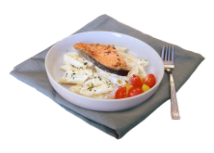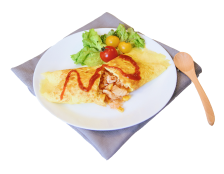Can dietary habits
prevent a migraine
attack?
The dietary recommendations in this section, provided by MSL (米施洛), are expert opinions from dietitians.

“435” dietary tips for migraine
In recent years, there have been an increasing number of studies investigating the linkage between migraine and different foods or dietary patterns.1 Although more data are needed to demonstrate that foods can trigger or prevent migraine, understanding your own response to different foods is a way to improve your migraine.1
The following are some daily dietary recommendations, referred to as “435 dietary tips”, including tips on the
4 types of foods to avoid or consume less of, 3 types of foods that can be increased in your diet, and a 5-step dietary pattern to reduce the frequency of your migraine attacks.
Dietary tips
4 less
diet recommendations
Certain foods are a migraine trigger in around 20% of migraine patients.2 For example, some people will eat chocolate to satiate their cravings for sugary foods while suffering from a headache.3–5 However, if the patient is intolerant to such foods (i.e., chocolate in this scenario), their headache could become more
severe.3–5
As a guide, the following are some foods that could be avoided or consumed less by migraine patients:
Patients should avoid drinking alcohol, such as red wine and
beer5–7
Excessive alcohol can cause vasodilation in the head, leading to an increase in blood flow, and thus could lead to a migraine attack.8
Smoking should also be avoided as nicotine in tobacco can affect blood pressure9
Drinking too much coffee can increase blood
pressure7,10
If you cannot do away with coffee completely, you should limit yourself to 1 to 2 cups a day. Enjoy it slowly to control the amount you drink, or considering replacing it with herbal tea.
Reduce consumption of foods high in tyramine5–7
Tyramine originates from food.11 Generally, the longer the food is left out or fermented, the higher the amount of tyramine it will contain.11 High tyramine levels in the body can cause nerve cells to release a hormone called norepinephrine, which could lead to an increase in blood pressure and heart rate, and hence could trigger migraine attacks.11
Foods containing tyramine
include5–7,11:
- Milk products, especially fermented cheese and yogurt
- Chocolate
- Nuts such as peanuts, walnuts and cashew
- Foods pickled or smoked with nitrates and canned foods such as sausages, salami, canned luncheon meat and other processed foods
- Citrus fruits such as orange, pineapple and grapefruit
In some patients, migraines can be triggered due to histamine
intolerance7,12
Additives such as monosodium glutamate, artificial sweeteners, artificial food coloring and preservatives contain
histamine.13 Consumption of such additives is difficult to avoid if you dine out frequently.
As such, reducing the frequency of dining out or only visiting restaurants you are familiar with are recommended.
3 more
diet recommendations
Frequently consume foods containing omega-3 fatty
acids
1,14
such as deep-sea fish that are rich in oil (e.g., salmon, tuna, sardines, mackerel), nuts and seeds (e.g., flaxseeds).1,14 Foods containing omega-3 fatty acids can inhibit the release of inflammatory cytokines and have anti-inflammatory effects, potentially beneficial to headache patients.1,15,16
Take in enough magnesium, especially for female
patients17
Magnesium-containing foods include brown rice, spinach, salmon, bananas and milk.18 Studies have shown that migraine patients tend to have lower levels of magnesium ions in their blood.17 Magnesium deficiency can affect the normal functioning of the nervous system and the normal contraction of blood vessels, which may also be one of the triggers for migraine attacks.17
Take in enough vitamin B and
folate
1,19,20
such as eating more dark green vegetables, fresh chicken, and folic acid enriched breakfast cereals.1,19,20 Vitamin B and folate can reduce the concentration of homocysteine in the body, providing protection to blood vessels, lowering the chance of thrombosis, stabilizing blood pressure, and reducing the chances of migraine.1,21–23
5-step
dietary pattern
Other than the above recommendations, dietary patterns can also play a role in preventing
migraine.1,4
The most basic step is to maintain a balanced
diet1,17
because the lack of certain nutrients (e.g., magnesium, folic acid) may induce
migraines.1,17
Drinking enough
water4,27
(i.e., 8 glasses of fluids per day) is also a way to prevent
migraines.4,27
Only eat fresh ingredients3,11
The longer food sits, the higher the level of tyramine it contains, regardless of whether the food is stored at room temperature or inside a fridge.3,11,25,26 Although the level of tyramine rises more slowly in food stored under room temperature, the level of tyramine within will increase within a few days.25,26 Therefore, it is recommended to only buy the right amount of ingredients each time you cook, eating fresh food , and to consume food within 2 days if storage is necessary11,25,26
Read food labels
carefully
28,29
especially to assess whether the food contains additives such as monosodium glutamate, nitrates/nitrites or aspartame.28,29 If you are intolerant to additives, avoid buying products that contain them to prevent headache
attacks.29–31
Eat 5–6 small meals every day regularly3,4,24
Missing a meal will cause your body to go into starvation mode, which is also a trigger for migraines.3,4,24
Consult healthcare
professionals and dieticians
To conclude, many factors can lead to migraines. Even if certain foods are migraine triggers, their impact varies from person to person. If you suspect certain foods to be a trigger for your migraine, keeping a record of your diet may help you find the source. Following random dietary patterns advocated by the public (e.g., ketogenic diet, low-glycemic index diet, low-carb diet) to reduce your migraine attacks is not recommended: there have been cases of malnutrition caused by excessive dieting, which could lead to eating disorders. Not everyone will suffer from migraine caused by specific foods.
Since many foods that may induce migraine are also on the food list, consulting your healthcare provider and dietician is recommended. Your dietician will guide and formulate a plan for you to record your diet. Recording the details of the food you eat every day, the time of your meal and your migraine attack could help you determine the specific triggers to your migraines. An elimination diet could be useful to help improve your condition.
A one-day
sample menu for reference
Sample menu:
Recipe
Recipe

Penne pasta with salmon and dill in white sauce
Download recipe
Soymilk waffle with banana
Download recipe
Fried tofu patty with small dried fish
Download recipe
Omelet with chicken and corn
Download recipe
